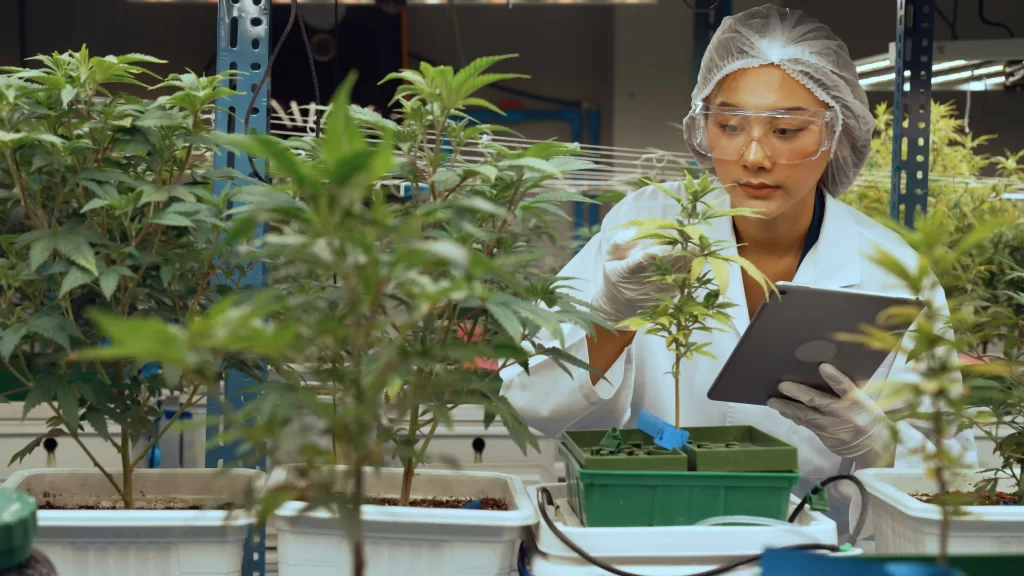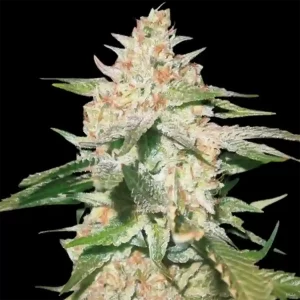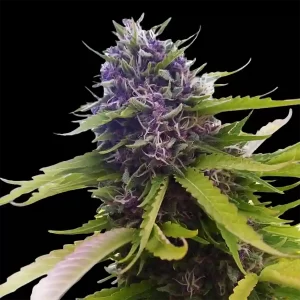Hop Latent Viroid, abbreviated as HLVd, poses a significant threat to the cannabis industry. In this article, we delve deeper into this relatively unknown plant disease. What is Hop Latent Viroid, how do plants get infected, and is there anything that can be done about it?

What is Hop Latent Viroid?
Hop Latent Viroid is a viroid that is rapidly spreading around the world and can infect, among other plants, cannabis. In large areas of Australia and the United States, the disease has already infected up to 90% of plants.
When cannabis plants are infected with HLVd, it leads to growth retardation, reduced yields, and decreased product quality.
First, let’s explore what viroid’s are.
Viroid’s represent a unique class of infectious agents discovered in the 1970s and consist exclusively of single-stranded RNA molecules.
In contrast to viruses, they lack a protein coat and rely on the host’s cellular machinery for replication.
Their discovery has had a significant impact on plant pathology, as viroid’s are notorious for causing diseases in various plant species, leading to significant agricultural losses worldwide.
HLVd in cannabis plants
Among viroid’s, Hop Latent Viroid (HLVd) stands out as a significant issue, particularly in the cultivation of plants within the Cannabaceae family, such as cannabis (Cannabis sativa) and hemp (Cannabis sativa L.).
Originally identified in hop plants (Humulus lupulus), it has been found that HLVd also infects cannabis and hemp, posing significant challenges for both growers and researchers.
Understanding the significance of HLVd in cannabis and hemp cultivation is of paramount importance due to the rapid expansion of these industries worldwide.
With increasing demand for medicinal and industrial applications, the presence of HLVd can lead to growth retardation, reduced yields, and decreased product quality.
This not only impacts the economic viability of cultivation but also raises concerns about regulatory compliance and consumer confidence.
How does HLVd develop and spread in cannabis plants?
The development and spread of HLVd in cannabis plants occur through various routes:
1. Infection via contaminated plant material: One of the main ways HLVd spreads is through contaminated plant material, such as cuttings or seeds. If a mother plant is infected, her offspring will almost always be infected as well.
2. Physical transmission: HLVd can spread through physical contact, such as when infected plants come into contact with healthy plants. This can happen during transplanting, pruning, or through the use of contaminated tools.
3. Biological vectors: Some insects and mites can transmit viroid’s from infected to healthy plants. Although less common than with viruses, biological vectors can play a role in the spread of HLVd.
4. Wounds and damage: When a plant is wounded, such as through pruning, insect feeding, or mechanical damage, it can provide an entry point for HLVd and other pathogens.
5. Excessive humidity: HLVd can thrive in environments with high humidity. Excessive humidity can promote the spread of HLVd by causing stress to the plants, making them more susceptible to infection.
Once infected, HLVd spreads within the plant by replicating its RNA in the host cells. It can cause various symptoms, ranging from mild to severe growth retardation, leaf deformities, yellowing, and decreased yield.
Learn more about growing weed in our how-to-grow-weed guide!
What can you do if your cannabis plants are infected with Hop Latent Viroid?
Hop Latent Viroid (HLVd) is a pathogen that can infect cannabis plants and cause damage. Here are a few steps you can consider if your cannabis plants are infected with HLVd:
1. Isolation and inspection: Isolating the infected plants can help prevent further spread. Carefully inspect the plants to determine the extent of the infection.
2. Destruction of infected plants: If the infection is widespread, it may be necessary to destroy the infected plants to prevent further spread. This may involve removing and destroying the entire plant, including the roots.
3. Quarantine: If you have multiple plants and only a few are infected, consider isolating the non-infected plants and closely monitoring them to prevent the spread of the infection.
4. Disinfection: Thoroughly clean all tools and equipment that have come into contact with infected plants to prevent further spread of HLVd.
5. Preventive measures: Take preventive measures to prevent future infections, such as using certified disease-free plant material, avoiding overcrowding of plants, and maintaining good hygiene practices in the growing area.
6. Consult a professional: If the infection is severe or if you are unsure of the best approach, consult a professional grower, agricultural expert, or other plant disease specialist. They can provide specific advice tailored to your situation.
It is important to note that the best approach may vary depending on the specific circumstances and severity of the infection. However, following these general guidelines can help prevent further spread of Hop Latent Viroid and maintain the health of your cannabis plants.
Is there a cure or treatment for HLVd-infected cannabis plants?
Unfortunately, there is currently no known cure or treatment for cannabis plants infected with Hop Latent Viroid (HLVd). This makes controlling the disease challenging, as viroid’s can be resistant to many common treatment methods, such as fungicides or pesticides.
Instead of relying on treatments, the focus is often on preventing infections and limiting their spread.
This includes measures such as using certified disease-free plant material, implementing strict quarantine practices, maintaining good hygiene in the growing environment, and minimising stress factors that can make plants susceptible to infections.
Because HLVd is a viroid, a smaller entity than viruses and lacking a protein coat, many common methods for treating viral infections are not effective against viroid’s.
Research into possible treatments for viroid’s is ongoing, so it is possible that new approaches will be discovered in the future.
However, at present, the emphasis is mainly on controlling the spread and minimising the damage caused by HLVd.
HLVd, everyone can lend a hand to solve the problem
Given the strict regulations and high consumer expectations regarding cannabis and hemp products, addressing the threat of HLVd is essential for ensuring the sustainability and profitability of cultivation practices.
Therefore, it is crucial to delve into the biology, epidemiology, and management strategies of HLVd to protect the future of cannabis and hemp cultivation from emerging plant diseases.
Finally, for every cultivation, starting with good quality genetics is key. Purchase your seeds or clones from a company that tests the seeds for Hop Latent Viroid. You can also ask for test reports.
At Irie Seeds all of our seeds and the genetics get pre-tested on many diseases including Hop Latent Viroid before importing them into Thailand. For us this is a very important step to eliminate Hop Latent Viroid form all of our customers grow.



